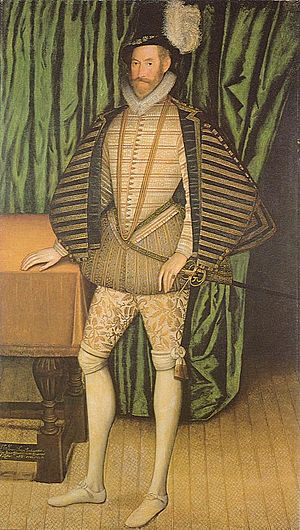Jerome Bowes facts for kids
Quick facts for kids
Sir Jerome Bowes
|
|
|---|---|
 |
|
| English Ambassador to Russia | |
| In office 1583–1584 |
|
| Member of Parliament for Lancaster | |
| In office 1601–1601 |
|
| Member of Parliament for Reading | |
| In office 1604–1604 |
|
Sir Jerome Bowes (who died in 1616) was an important English diplomat. He served as an ambassador to Russia. He was also a Member of Parliament in England, which means he helped make laws for the country.
Contents
Early Life and Connections
Jerome Bowes was born into a family from County Durham in England. His father was John Bowes, and his mother was Ann Gunville.
As a young man, he joined Edward Clinton, 1st Earl of Lincoln, on a trip to France. This trip was to get revenge after the French captured Calais, an English town. Jerome Bowes was connected to important people at court, like Robert Dudley, 1st Earl of Leicester. However, he sometimes had disagreements with them.
Ambassador to Russia: A Tricky Trip
Sir Jerome Bowes became an ambassador to Russia in 1583. This was a very important job.
Why Go to Russia?
Before Bowes went to Russia, a Russian diplomat named Fedor Pisemsky had visited England. The main reasons for Bowes's trip were to discuss trade between England and Russia. There was also talk of a possible marriage between the Russian ruler, Ivan the Terrible, and Lady Mary Hastings. She was a relative of Queen Elizabeth I.
In June 1583, Bowes sailed to Russia with Pisemsky. However, his mission did not go as planned. It turned out to be a difficult and unsuccessful journey.
Standing Up to the Tsar
Stories about Sir Jerome Bowes's time in Russia show he was very brave. One story says that Ivan the Terrible once nailed a French ambassador's hat to his head. When Bowes met the Tsar, he kept his hat on. Ivan threatened to do the same to him.
Bowes bravely replied that he represented the powerful Queen of England. He said she bowed to no one. Ivan was impressed by his courage and liked him for it. Another story says Bowes tamed a wild horse so well that it died from the effort.
Bowes also insisted on giving Queen Elizabeth's letters directly to the Tsar. This was against the usual rules. He also told Ivan that Queen Elizabeth's father, King Henry VIII, was even more powerful than the Holy Roman Emperor. Ivan became angry and hinted that Bowes might be thrown out a window. Bowes calmly said the Queen would get revenge if anything happened to her ambassador.
Ivan's anger soon turned to admiration. He even talked again about a marriage between his family and Queen Elizabeth's relatives.
Mission Ends
Sadly, Ivan the Terrible died soon after these events. His son, Feodor I, became the new ruler. With Feodor, a group that did not like England gained power.
Some historians, like Alfred Nicolas Rambaud, thought Bowes was clumsy and not very good at diplomacy. Bowes was held prisoner for a time and threatened. Eventually, Feodor dismissed him. As he was leaving Russia, Bowes sent back the new Tsar's gifts, calling them "paltry."
Later Years and Legacy
After his time in Russia, we know less about Sir Jerome Bowes. He was elected to Parliament twice. He represented Lancaster in 1601 and Reading in 1604.
He also received a special permission to make drinking glasses in England and Ireland. He lived in Charing Cross in London. Sir Jerome Bowes was buried on March 28, 1616, in Hackney Church. A painting of him, made during his time as ambassador, can be seen in the Suffolk Collection.
Writings
When he was not busy with court duties, Sir Jerome Bowes translated a book from French. It was called Apology for the Christians of France ... of the reformed religion (1579).

